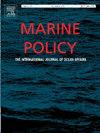在沿海聚集区发展可持续鲸鲨与人类互动的关键要素
IF 3.7
2区 社会学
Q2 ENVIRONMENTAL STUDIES
引用次数: 0
摘要
在过去的75年里,鲸鲨(Rhincodon typus)的种群数量显著下降了50% %以上,这主要是由于人为的压力。虽然近几十年来对鲸鲨旅游的需求不断增加,促进了许多当地社区的经济,但旅游活动可能会给鲸鲨的行为带来压力或改变。Bahía de La Paz(墨西哥)是鲸鲨的沿海聚集区,自2005年以来,旅游活动一直受到监管,尽管2018年实施了新的保护战略,旨在实现更可持续的做法。2005年至2016年的监测数据显示,鲸鲨的丰度随季节和年度变化而变化,30% %至60% %的个体(每年约50-120)有与船只有关的伤害。2016年,在80条已确定的鲸鲨中,高达77% %的鲸鲨遭受了与人为有关的伤害。为了减少鲸鲨的伤害,政府对旅游管理计划进行了几项修改。本研究详细描述了墨西哥政府实施的保护策略,以更好地管理人类与鲸鲨的互动,旨在改善旅游实践,减少与船只有关的伤害。在实施的策略中,我们强调1)区域调整,2)使旅游季节适应鲸鲨的季节,3)实施承载能力模型,4)实施卫星跟踪系统,5)增加巡逻,6)限制授权船只的数量。十多年的鲸鲨监测对建立Bahía de La Paz至关重要,这是一个高需求的旅游目的地,是该物种的重要栖息地。本文章由计算机程序翻译,如有差异,请以英文原文为准。
Key elements for developing sustainable whale shark-human interactions in coastal aggregation areas
Whale shark (Rhincodon typus) populations have significantly declined more than 50 % in the last 75 years mainly due to anthropogenic stressors. While the increasing demand for whale shark tourism in recent decades has boosted many local community’s economies, tourism activities may stress or alter whale shark behavior. Bahía de La Paz (Mexico) is a coastal aggregation area for whale sharks where tourism activities have been regulated since 2005, although new conservation strategies were implemented in 2018 aiming for achieving more sustainable practices. Monitoring data from 2005 to 2016 showed whale shark abundance varied seasonally and annually, and that between 30 % and 60 % of the individuals (∼50–120 each year) had boat-related injuries. In 2016, up to 77 % from 80 identified whale sharks had anthropogenic-related injuries. To reduce whale shark injuries, the government introduced several modifications to a tourism management plan. This study describes in detail the conservation strategies implemented by the Mexican government to better manage human interactions with whale sharks, aiming to improve tourism practices to reduce boat-related injuries. Among the implemented strategies we highlight 1) Zone adjustment, 2) Adapting the tourist season to whale shark seasonality, 3) Implementing a carrying capacity model, 4) Implementing a satellite tracking system, 5) Increasing patrols, and 6) Limiting the number of authorized boats. More than a decade of whale shark monitoring was crucial in establishing Bahía de La Paz, a highly demanded tourism destination, as a critical habitat for the species.
求助全文
通过发布文献求助,成功后即可免费获取论文全文。
去求助
来源期刊

Marine Policy
Multiple-
CiteScore
7.60
自引率
13.20%
发文量
428
期刊介绍:
Marine Policy is the leading journal of ocean policy studies. It offers researchers, analysts and policy makers a unique combination of analyses in the principal social science disciplines relevant to the formulation of marine policy. Major articles are contributed by specialists in marine affairs, including marine economists and marine resource managers, political scientists, marine scientists, international lawyers, geographers and anthropologists. Drawing on their expertise and research, the journal covers: international, regional and national marine policies; institutional arrangements for the management and regulation of marine activities, including fisheries and shipping; conflict resolution; marine pollution and environment; conservation and use of marine resources. Regular features of Marine Policy include research reports, conference reports and reports on current developments to keep readers up-to-date with the latest developments and research in ocean affairs.
 求助内容:
求助内容: 应助结果提醒方式:
应助结果提醒方式:


